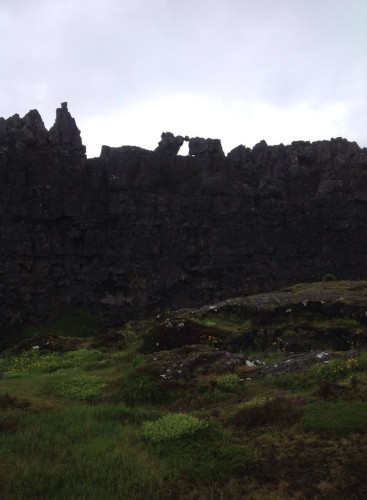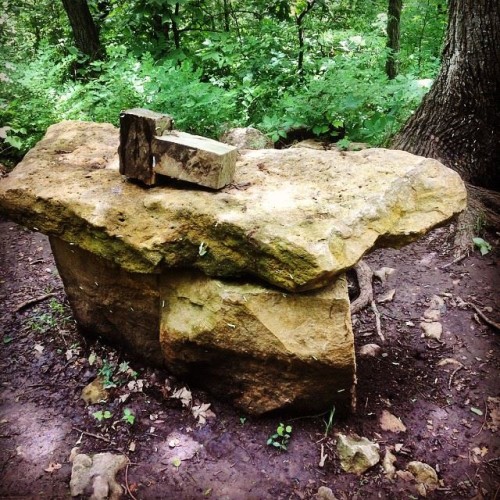[Columnist Eric O. Scott is one of our talented monthly columnists and the creator of the Viking Panda. If you enjoy reading his work, consider donating to our Wild Hunt Fall Fund Drive and help us to bring you daily news and commentary. We are completely reader-funded, so it is you that makes it all possible! And, if you do contribute at the correct level, you will receive your very own Eric Scott Viking Panda drawing. Donate today and help keep The Wild Hunt going for another year. Thank You.]

Your author is supposed to get through all of these books by December. Gulp.
[Photo Credit: E. Scott]
To read these pilgrim tales, especially those from the classical and medieval periods, is to be drawn into a foreign world where such travel was rare, expensive, and dangerous. It seems that every medieval expedition to Jerusalem involved at least one pirate attack, forcing even pacifists like the Franciscan friar Niccolo da Poggionsi to take up crossbows in self-defense. The ocean and the desert constantly threaten to devour those souls who attempt to cross them; while the autobiographers obviously survive to tell their tales, one has to wonder how many failed.
One thing that these old texts seem to lack, however, is a sense of personal revelation upon reaching the destination. Niccolo’s account of his pilgrimage, for example, stops using the first person voice entirely once he reaches the Holy Land, even though he uses it to describe his voyage in moving and dramatic detail. Consider his description of the Garden of Gethsemane:
On the road that leads up to Mount Olivet, you find on the right a piece of a wall and you enter a small plain, kept like a garden with trees. This place is called the flowery garden, in which Christ was arrested, and by Judas Iscariot betrayed. And here the Apostles slept when Christ prayed to his Father. And here was raised a church, which is now in ruins, and there are two big stones; and it is said that in that place Christ will stand with all his Apostles, to judge the just and the unjust; therefore the pilgrims pass the place on the right and say: Jesus Christ, make me stand on this side, me and my relatives. In this garden there is an indulgence of VII years.
To my modern eyes, this seems like such a strange passage. Niccolo is writing about one of the most important places in his religion – the garden in which Jesus was turned over to the Roman authorities, directly leading to the Crucifixion. Yet there is no portion of his commentary that focuses on his own emotional experience of being in the place where his god once stood, no sense of awe, or wonder, or disillusionment. And this is the case with all of these older pilgrimage accounts, too; for some reason, the Holy Land does not bring out the kind of enthusiasm one might expect from someone devoted enough to risk their life to visit. In some cases, we have nothing more gripping than a list of room measurements and the number of years one might be able to shave off of Purgatory. It’s not until quite recently – the 18th and 19th centuries, as best as I can tell – that the personal sentiments of the author begin to get expressed. Even in The Innocents Abroad, one of Mark Twain’s lesser-known books, wherein Twain goes on a “pleasure cruise” to the Holy Land with a group of other Americans (the “innocents” of the title), much of the text reads like a scoffing guidebook. Yet we begin to find passages like this one, a reflection Twain makes just after finally arriving in the Holy Land:
We do not think, in the holy places; we think in bed, afterward, when the glare, and the noise, and the confusion are gone, and in fancy we revisit alone the solemn monuments of the past, and summon the phantom pageants of an age that has passed away.

Þingvellir, Iceland.
[Photo Credit: E. Scott]
Take, for example, the impact of history on the significance of a pilgrimage site. Twain’s quote takes it as a given that a “holy place” must, by definition, evoke those “phantom pageants of an age that has passed away.” And indeed, in the Abrahamic milieu in which The Innocents Abroad takes place, that statement rings true. It is also true in some cases for modern Pagans – Rountree’s Goddess worshippers visit neolithic sites in order to connect with a “deep past” that doesn’t seem to exist in their own back yards, and, in my own experience, part of the majesty of seeing Þingvellir for the first time came from how important that place was to the Heathens who settled Iceland. But the most common kind of pilgrimage undertaken by modern Pagans, at least in the United States, is to places like the Doubletree Hotel in San Jose or my own beloved Gaea Retreat in Maclouth, Kansas – sites of living, vibrant religious festivals, places where the concern is on the here and now, not the “solemn monuments of the past.” And in the place of Niccolo’s impersonal descriptions of Biblical sites, we now have a Pagan internet full of personal reactions and experiences, the emotional intimacy of which would shock the autobiographers of old.

The Forn Halr altar at Gaea Retreat.
[Photo Credit: E. Scott]
The Wild Hunt is not responsible for links to external content.
To join a conversation on this post:
Visit our The Wild Hunt subreddit! Point your favorite browser to https://www.reddit.com/r/The_Wild_Hunt_News/, then click “JOIN”. Make sure to click the bell, too, to be notified of new articles posted to our subreddit.

Perhaps in the early days a pilgrim’s disclosure of what was personally revealed at a holy site risked a charge of heresy. The authorities were a lot less tolerant of UPGs back then.
Very interesting article! I had not considered the modern Pagan festival phenomenon as a form of pilgrimage, but thinking back on the stories people have written about their experiences, I can see it. Only in the case of the festivals the pilgrimage is not towards a holy site but a holy experience.
I am sure that Margery Kempe was on your reading list. I swear, I had her reincarnation as a student once, and I could see why MK’s fellow pilgrims walked faster trying to get away from her.
Couldn’t remember Madame Kempe, so looked her up. Oy, what a pain in the tuchus she must have been, forever crying, kvetching, and lamenting. I think that was 7 hours ago–Wikipedia can be a massive time sink!
One of the sources for the article on her is
Torn, Alison. “Medieval Mysticism Or Psychosis?.” Psychologist 24.10 (2011): 788–790. Psychology and Behavioral Sciences Collection. Web. 8 October 2013.
There were arguments at the time about whether some people were suited for being anchorites, or whether it would addle their brain. Sounds to me as though there were mystics and there were “mystics”. *I* would certainly go stir-crazy!
Wikipedia says:
Striving to live a life of commitment to God, Kempe in the summer of 1413 negotiated a chaste marriage with her husband. Although Chapter 15 of The Book of Margery Kempe describes her decision to lead a celibate life, Chapter 21 mentions that she is pregnant once again. Kempe gives birth to a child, her last, during her pilgrimage, and later relates that she brought a child with her when she returned to England. It is unclear whether the child was conceived before the Kempes began their celibacy, or in a momentary lapse after it.
Apparently she wasn’t any better than a certain deluded politician’s daughter about the abstinence bit.
I did learn that anchorites, such as Julian of Norwich, who she visited, were too pious to live in the world…and had their needs catered to, in their tiny solitary dwellings.
You are correct that we are creating the hoary old sacred traditions of the future. I wonder though if distant pilgrimage will be common outside of some Greek, Roman, and Egyptians. It would seem that some of the Polytheists religions are more grounded to local sites.
As we create our traditions we might be wise to see what has not worked before in other religions creating traditions or that might not be something that we wish not recreated in our modern version of the old Pagan religions. Keeping of heads of enemies, or decorating temples with the standing headless bodies of the dead might not work so well for our modern sensibilities, the same with human sacrifice. [Grin]
Well, Eric, yet another good one. I don’t envy you the reading work load.
I don’t know that *I* don’t think in holy places–mostly I’m trying to be present in the moment and experience what I can in those places, as well as those places that make me stop in awe and possibly breathless as well.